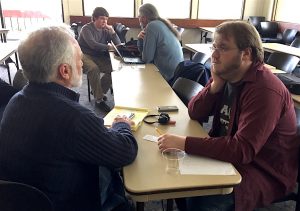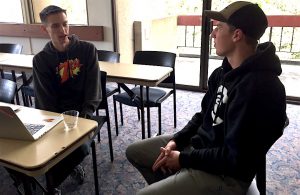A small group of fresh freelancers came to hear a panel of seasoned freelancers—with a combined century of experience designing, producing and integrating code, consulting, producing technical specs and manuals, teaching and supporting technical sales—share their experiences. The almost 1:1 ratio of audience members to panel members provided an intimate atmosphere and ensured that audience members would gain valuable insight into the world of freelancing.
And, Begin…
Karen launched the workshop by stating that, in her opinion, we are all self-employed; only the relationship structure and payment format changes when we elect to work full-time for a company. Further, the industry disruption we are experiencing will continue to fragment the workforce, and the concept of being taken care of by a Mommy—in the form of a perq-providing company—will disappear from the workplace … everyone will be on their own.
She introduced the individual panel members and asked them about their backgrounds.
Jay Toral: Jay is the Millennial Consulting Executive. With over 14 years of business ownership experience, he helps a new generation of entrepreneurs bring their skills to market in a modern, online economy.
Jay has worked as both a consultant and a contractor. The impetus for him to begin freelancing was his desire to work outside a stifling environment; he was very motivated to be his own boss. His method for finding contract positions is to apply for permanent jobs and then, during the interview, suggest a contracting position. He has—and does—telecommute and has traveled to client sites via train. He noted that you can work on a project—and bill your time—while you travel on a train and enjoy the changing scenery!
Alastair Weston: Alastair is a freelance software developer from Minneapolis MN. Specializing in web development since 1997 and mobile software since 2005, he has crafted excellent solutions for hundreds of clients around the globe.
Alastair works as a contractor while he attends SOU. The impetus for him to begin freelancing was to alleviate the migraine headaches he experienced; that worked! He finds contracts by word-of-mouth and occasionally visits referral job sites like Freelancer. He telecommutes and travels to client sites, as required by the contract.
Dave Hendrix: Dave is a veteran of many programming languages, several startups (some successful, some not), and some larger companies you may have actually heard of. He might be a seasoned coder, but he still wakes up every morning excited about the prospect of getting to make things with code.
Dave works as both a consultant and a contractor for consultants. His desire for a regular change of scenery and being able to set his own hours provided the impetus to begin freelancing. His iOS app development contract jobs are primarily obtained via word-of-mouth referrals. He telecommutes but travels only to local client sites.
Leslie Wilson: Leslie is an artist who works with both digital and traditional media. Her computer installations, animations, prints, and textiles have shown in a variety of venues worldwide including art galleries, museums, and SIGGRAPH conferences. She is currently the UX Designer for FlowJo, LLC in Ashland.
Leslie has been a contractor and is now taking a break from contracting as she manages UX design for a local company that produces and markets patented software used by life science researchers worldwide to analyze data collected from flow cytometry equipment. The impetus for the change is: family. She previously found contracts via referrals and staffing companies, during transitions to and from employment.
Jason DeShazer: Jason graduated from SOU in 2014 with a dual degree in Computer Science and Mathematics. He’s now attending SOU for his Master’s in Business Administration. Jason is a web developer and consultant. He works for the IT department at the Oregon Shakespeare Festival (OSF)
Jason works as a contractor while he attends SOU. He stated he has been independent by nature since the age of twelve. He networks to initiate relationships that lead to contracts. He telecommutes but travels only to local client sites while he wraps-up his Master’s Degree program.
Karen Allport: Karen is a seasoned freelancer with decades of experience producing custom systems in both large and small business, non-profit and government settings. After graduating from SOU in 2005 with a degree in Business Administration and C.S., she retired. She now volunteers her time producing Tech Workshops at SOU, a hands-on workshop program intended to introduce third- and fourth-year C.S. students to new technology—and to the art of networking. In her spare time, she manages Rogue Tech Hub where the mission is: Connect The Tech In The Rogue Valley!
Karen was a serial contractor; managing one project at a time. The impetus for freelancing was: getting fired. Her first contract lasted three months. After returning to the corporate world via a connection made at a swim & health club, she worked at a technical sales support job for two months before the company had a layoff. Fortunately, a position opened up at the corporate level (upstairs, in the same building) during the same layoff, and she moved on up. Upstairs, she provided technical sales support at a national level … until … she got fired again. Finally realizing she was not cut-out for corporate life, she launched her own consulting business. Lesson Learned: Success is easier when you properly-align your aptitudes, skill set—and attitude—with those required by the job.
A networking fanatic, she started her own tech networking group to expand her base of contacts. She has telecommuted and flown to client sites all over the country, had a second home several times (often in a hotel; sometimes in an apartment), and worked on billable projects while commuting to client sites via Amtrak. She decided to cap-off her career by collecting her credits from six previous universities and enrolling at SOU, and then spent a casual four years finishing her B.S. Then she retired … and started a networking group.
Group Exercise #1: Introduce Your Company
Karen triggered the first exercise by asking the audience to take out paper and pencil and write down the name of their company, the company type (consultant: on-going retainer with multiple companies; or contractor: project-based), and a mission statement.

Each member of the audience then stood up and introduced themselves and announced the name of their company, company type, and mission statement. Once everyone had introduced themselves, we began the presentations.
How Much Do I Charge For My Services?
Jay addressed the most often asked-about topic: How do I figure out what to charge for my services?
The primary considerations are:
- How do I compete with more experienced consultants in my field?
- How do I deal with the issue of not knowing everything about the proposed project or language or environment; IOW how do I get paid to learn?
Create a Menu of Services
Jay’s first suggestion was: Set up a menu of 5-10 services that you offer, and include a number of hours for each item, along with a list price for each service.
As for determining an hourly rate, Jay suggested that a starting point might be to charge one dollar per minute. This number includes a time allotment for studying the project the client wants and a time allotment to actually produce the deliverables. If you think you will spend 50% of your time studying (project, language, software tools) because you’re new, then split your rate in half. What a great way to define the kind of services your company will offer!
An impromptu survey of other panel members regarding the manner in which they charge for services resulted in the following comments:
- Dave: Based upon the type of projects (iOS app custom development), he charges by the hour.
- Alastair: Discussed what to do when the project overruns the estimated time—or projected cost estimate. He encouraged new consultants to include a specific number of revisions to the deliverables when producing the contract.
- Karen: New consultants might consider a formula to tie their hourly rate to their current level of expense, and then make adjustments (via discount) for quick pay, product/process inexperience, and various other factors. Then, as experience kicks-in, or demand increases, discontinue the discount. The formula can be found within the downloadable Individual Marketing Plan document in the Freelancing InfoCapsule.
Say,“Custom” Instead of “Fix” or “Change”
Alastair offered a great suggestion: avoid using the words “fix” and “change” and instead opt for the word “custom” when dealing with requested alterations to the original agreement. He offered an analogy relating to getting your car serviced. Before the mechanic puts in the fresh oil, you ask the mechanic to swap-out the spark plugs. Of course the mechanic can do that, but that’s new work; in addition to the original request.
Bottom Line: When you’re building your menu of services, clearly outline what is included for each line item and the number of changes they will be allowed to make before the cost goes up.
Tracking Your Time; Benefit
When building a menu of services, one thing that might be helpful is to have a record of the time you have spent doing similar work on previous projects—and have recorded as line items on your previous invoices. Recording your time by segments or chunks, instead of summarizing your work by day or by project, helps you estimate time to repeat some of the same tasks for a new project. And, having categories of changes might help explain to a client why some changes take more time and why some changes take a moment—or only need a switch flipped.
Taking Responsibility for Mistakes
Alastair also admonished new consultants to take responsibility for anything that is not working per the design; don’t try to deflect responsibility to another entity, as this may have the effect of reducing your professional esteem in the eyes of the client … because they didn’t make a mistake…you were the one working on the project, so who else could be at fault?
If, in fact, a mistake was not your fault, sometimes it is worth taking responsibility for the issue anyway; this increases your esteem in the eyes of the client. Making a change that benefits the client will help the trust factor in addition to the esteem factor.
Group Exercise #2: Menu of Services
Jay’s exercise for the group was to make a menu of services and then stand up and tell the group what services they plan to provide. He lauded those who were more specific about their services and emphasized that being fairly specific, especially with things like Game Development, was better because some offerings might entail many add-ons that might lead to requests for free work before the client considers the project to be complete.

One specific suggestion for Game Developers was to break-down their menu of services by character; IOW, set the prices by the number of characters, which includes research and production time.
Special Tools For One-Off Projects
A great question came up from the audience: How do you set your pricing if you know you’re going to take on a project that will involve purchasing special tools; either hardware or software? Do you build that into a custom quote? Do you determine that you will need this item for multiple clients and absorb (or, write-off) the cost? Jay suggested that something like this be billed to the client at half of any hardware costs. (Optionally, the client might wish to purchase the item for their own company, loan it to the consultant for the duration of the project and then return the item to the company upon completion of the project; the client could expense the item and either retain or eventually sell the item.)
For software licenses—a lot of those are Software As A Service (SAAS) apps or monthly—Jay said he bills those out on a monthly basis and once the project is complete, he cancels the service. If the required software is something like PhotoShop, he builds that into the rate he’s charging the customer. If specialty software is involved for only this project—like some sort of a floor planning app—he bills the cost directly and puts the line item on an invoice.
Sub-Contracting
A question arose regarding sub-contracting: A client wants to use the primary contractor and a sub-contractor, depending on the amount of work at any one time; billed hourly. This goes back to having a menu that lists specific items and usual times. This question applies to an à la carte menu; navigating the project by the hour.

RELATED. Who is the Primary Contractor: Client or Consultant?
If the primary contractor is the client, the consultant must proceed in whatever manner the client requests.
If the primary contractor is the consultant, the sub-contractor takes direction from and interfaces solely with the consultant. The consultant may bill out the sub-contractor’s time as a separate line item or bundle the sub-contractor’s time with their own time. In this case, be sure to clearly state that the time is bundled so the client understands they won’t be receiving a separate invoice for the sub-contractor’s work. CAUTION: Be certain to have a sub-contractor submit a W9 IRS form that declares you are not liable for their withholding; penalty is treble.
Project Assistance
Another question was about Project Assistance; billing by the hour. Jay recommended listing that service on the menu as Project Assistance and then declare an hourly rate for coming up to speed, and to also include time for training, and then include some time “in the middle” for the actual work. So, maybe five hours to come up to speed, a couple of hours at the end for training and documenting your work, and some TBD number of hours for the actual work.
Be aware that some clients might hire a contractor under the guise of assisting their employees who they hired to do the work but then discovered those employees were not yet ready to do the work for which they were hired. This can be a potential red flag situation (see below), and contractors may want to be clear about the boundaries—and prepare for possible political situations regarding responsibilities and blame. Remedy: CYA.
Legal Stuff
Alastair took the floor and spoke about contracts and specifications, and how to deal with clients who disagree with the completeness of deliverables. He cited an example of a worker whose boss tells him they are not going to be paid this week, and emphasized that, as an employee, you have an implicit contract with your employer to be paid on a timely basis. With a contractor/client relationship, there is no implicit contract; there’s either an explicit contract or you’re on your own. So what do you do if/when a client decides that he doesn’t want to pay for work?
Alastair recommended RocketLawyer as a great place to get contract templates. And he talked about how having an attorney to contact may be helpful in extreme situations like a business partner stealing money, a contentious IP situation, and ownership of hardware and technology. He stressed that the point of a contract is as a communication vehicle; so both sides are clear on the terms of the arrangement.
He then led the audience through the process of creating a contract; the fundamentals:
- How long the project will take; time or completion criteria.
- How much the project will cost; hours and dollars.
- Specific milestones so dates can’t be changed at will; this helps both sides understand the status and provides a point where the client can pay for work completed to that point.
- A clause that states you, as the contractor, have the right to include the work you perform on the project in your portfolio. Sometimes, the work or the topic is proprietary and cannot happen; however, this is a good point to address during contract negotiations. Content might be as simple as a screen shot or as complex as who owns the source files. In his experience, Alastair mentioned that the primary concern for most clients is: the deliverables.
- A charge for communications; whether via phone, text or email; this takes time and, thus, is a cost that should be borne by the client.
Alastair told a story about a client contacting PayPal to claw back payments after declaring his work to be unsatisfactory. After contacting PayPal’s Fraud Department, he was able to point to his work—and the fact that it met the terms of the contract—and funds were redeposited to his PayPal Account.
The next suggestion offered by Alastair was: the Freelancer website. His experience was that this is a place where you can get work done; students attending a college in India bid on projects and the projects become their homework they then charge the client for. No customization, though.
For a list of other sites offering to connect freelancers with jobs, you are invited to visit Entrepreneur Magazine’s List.
Alastair then shared a story about someone who wanted him to complete a website, and he did some due diligence only to discover that the existing website was only a shell created via JavaScript with no content beneath the visible.
So these are things to consider:
- Rights of ownership; code, intellectual property (IP), hardware, software packages.
- Whether or not you generate content.
- Freelancer’s Union has good services available for freelancers, including health insurance and fill-in-the-form gaming contract templates.
Additional considerations provided by Jay include:
- Deliverables; be specific.
- Deadline; be specific.
- Rate/Estimated Total; be clear.
- Number of Revisions; be specific.
- Ownership of Source Files; be clear.
- Emergency/Overages/Existing IP
- Nolo is also a good resource for contract templates.
- Provide to the client a “first draft” of the contract for them to review prior to final signing.
Surprise Announcement #1
Contractors: Your client has just been bought-out by a competitor; your contract has been cancelled. What do you do? How many contracts do you have in your pipeline?
Consultants: You have a phone call: Client #2 has an emergency: their system has been hacked. You have a call interrupt: Client #3 has an emergency: their system has been hacked. How do you prioritize? Highest paying client? Oldest client? Client willing to pay a Speed Fee?

Which Language, When?
Dave addressed the issue of which language(s) are best.
One of the things you may discover, starting out, is: whatever languages you know will dictate the projects you get. If you know C#, you’re probably not going to get iOS contracts. His recommendation is to continually explore rather than follow a single path of one language. The truth is that, once you’ve spent time developing in a couple of languages, a new language is much easier to pick up.
Know Your Tools
Dave encouraged prospective freelancers to develop strong skills that include understanding the compiler, debugger and other tools that you will use on a regular basis so you are comfortable with them when you need to use them.
Always Be Learning
Alastair shared that he often was working just outside of what he was comfortable with. He once had a contract where he had to quickly learn C#; when the customer asked if he could do the job in C#, he said, “absolutely!” Then he learned C# and discovered the language was very close to other languages he already knew. He panned Flash and, along with Jay, recommended HTML5 Canvas.
Deprecated Software
Leslie mentioned that she programmed in Flash for decades, and agreed that HTML5 Canvas is a good replacement.
Dave chimed in with a comment regarding the HTML5 tools not being as robust as those in Flash; all agreed.
Macro Economic Factors
Leslie brought up macro economic factors; when and how to leave a safe corporate job for freelancing and when to return to the corporate world.
Early on, she entered the corporate world because she wanted to use bigger and better hardware; there was only so much she could do on a Commodore Amiga. After a while she realized that she was not making the gains she wanted to make; that can really color the job and make you unhappy the whole time you’re out working for someone else.
When she was younger and didn’t have a family, she found that balancing her personal need for freedom of expression with computing and the job requirements was much easier. She was able to do freelance work and still work for a corporation but as time passed and she had a family, the amount of money she had to earn increased; for example: health care. Twenty years ago, the cost may have been $5,000 each. Now the cost is more like $15,000 each. And as her family is aging, these issues made her reconsider a corporate job. So that’s just one example of what might make you return to working for a company full-time.
Stay In Touch!
Leslie recalled that a long-time cameraman friend who was based in Hollywood and was always employed, used to have a giant Holiday Party every year, and sent out greeting cards. Then, whenever he needed a job, it seemed like one of these contacts came through for him.
So she decided to send out cards every year, but she shifted from Holiday Cards to Valentine’s Day cards, and that has paid off. And, there have been so many times that she has been grateful for relationships that she has kept up from job-to-job.
What a great lead-in to the next topic!
Promotion & Networking
Jason spoke about promotion and networking, and offered a couple of examples to demonstrate why networking is so important.
Networking is important, especially for those of you who go to school here and will soon be looking for a job with little or no experience and may not have much of a portfolio—yet.
Networking can be a really great way to get out there and build-up your interpersonal skills by talking to seasoned professionals. Networking is also a good way to promote yourself with limited experience.
Marketing and advertising are really important but if you don’t have something concrete to advertise, word-of-mouth might be the best way to connect with jobs when you’re starting out; this was helpful for me.
Two ways Jason has been successful in networking are: attending events like this to meet other professionals and talking to them about what they do and how they work—and learning first-hand from their experiences. Networking events have a ready source of common interest that readily breaks the ice.
What’s really important in networking is building rapport with others; selling your personality and skill set, and learning about what others do. Then, in the future, if they are looking for somebody that has your skill set, they may remember you and contact you for work.
Building rapport with someone is not only a relationship between you and them, it may be helpful when they know someone else who needs your skill set—and they might refer them to you.
Exercise #3: Networking
Jason invited the audience to pair up and sell their skills to each other.

Karen handed out business cards and explained how easy it is to create your own. She explained that she put contact information on the front and information about what she does on the back side of the card. Then she encouraged them to add everyone they meet to their contact list, including the date they met, where they met, and a note regarding their skill set.
Business Considerations
A general discussion of business topics was next. We polled the panel for answers to the following questions:
- Three people you need on your team: Attorney, Banker & CPA; what do you look for?
- Banker: small regional bank or credit union. People’s Bank of Commerce; First Community Credit Union.
- Attorney: Legal Shield for $35/month; you can talk to an attorney on the fly. RocketLawyer.
- CPA: necessary for learning about how to do your own taxes. Fresh Books; QuickBooks. (Check with your CPA, in case they have a preference for a specific brand.)
- CAUTIONS:
- For Obamacare, you need to show deductions for qualifying for various aspects.
- Pay attention to quarterly filings!
- Cash Flow: Encourage inflow; prioritize outflow.
- Alastair: try to get three jobs for every one I take.
- Billing Frequency: Weekly | Monthly | Retainer
- Dave: monthly or by milestone.
- Jay: If you go monthly, it better be someone you trust!
- Bankruptcy Protection: Plan for it.
- Don’t ass-u-me you will be paid on time for every invoice you submit.
- Journal!
- Keep a journal; contemporaneous notes are legal documentation. Casual chats, phone calls, emails, Skype, etc.
- Document events in emails; creates an automatic—and legal—date/time stamp.
- Create a database or formal journal that is searchable.
- Publishing: Promote your technical know-how.
- Write and publish articles for both promotional and technical purposes.
- Practice writing skills by writing letters to corporate CEOs. If you get a reply (usually from the CEO’s staff letter writer), you probably wrote a good letter.
- Be organized!
- Know where to find customer information: company, contact, project status.
Surprise Announcement #2
You have a phone call: a local business needs a new consultant to take over a project started by a consultant who got hit by a truck. There is no spec, no status and no documentation. What do you do?
Memorable responses from the audience:
- Triple your rates.
- Project Truck Number (a project viability metric): How many developers can get hit by a truck before the project is cancelled?

Consulting Considerations; Tips
- Business Vocabulary; be able to talk the client’s talk.
- How to find work: Network!
- Research your client; they research you!
- Non-technical skills: Professionalism; dress, demeanor, attitude!
- Manage time appropriately: show up on time and properly-account for all your time.
- Specifications (“specs”): don’t work without one!
- Delight the customer; exceed expectations.
- How to get fired gracefully:
- Give the customer all the contact information to support or hosting services, passwords, login instructions, and what to do if the consultant gets hit by a truck.
- When you leave, document everything (work, agreements, casual interactions) you’ve done for them, sign it, and give it to the customer.
- Adopt the attitude that the customer owns everything; take nothing with you.
- Do your homework up-front; getting fired is nature’s way of letting you know there’s a better fit for your aptitudes and skill set elsewhere.
- Don’t be afraid to reach out to the person who has the resources (job, contract, connection) you want.
Final Exam
Audience! Stand up and promote yourself to us. Tell us what you’ve learned today.
What The Audience Members Learned
- Networking!
- Menu list of services.
- How to advertise myself.
- Contracts.
- The idea of applying for permanent jobs and then switching to consulting during the interview.
- Never say, “I can fix that!” Instead say, “that’s custom!”
- Be precise about what the line items cost when you list them on your menu of services.
- Articulating your skills
- Networking; understanding that the people you meet may know other people who might be able to help you connect with a contract or job.
- Vocabulary; know the client’s buzz words and business vocabulary for the best possible communication experience.
- All the different pieces that go into a contract; emergency clause.
- Set up organization for each contract; a system or a template.
- Follow your joy; if you’re not doing that … well … go get a corporate job until you figure out your passion.
Red Flags; Preparing for Pitfalls
- Anybody who does not care about the details of progress (“Just send me a bill…”) or what the meaning of a contract is, don’t work for them.
- Signing an NDA before they’ll talk about their project.
- Anyone who cannot give you a proper password.
- Have your antenna up for internal politics; be clear about your work boundaries.
- Client who’s unwilling to participate in the project or crafting a Statement Of Work (SOW) or Memorandum Of Understanding (MOU).
- Know your client and understand their company. Why are they hiring a consultant?
In Closing…
Karen thanked the panel members and the audience members for their participation, and wrapped-up the Freelancing Tech Workshop by reciting the following quotation:
Whatever you can do, or dream you can, begin it. Boldness has genius, power and magic in it.
~ Johann Wolfgang von Goethe